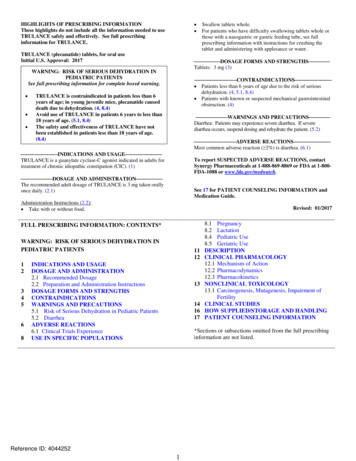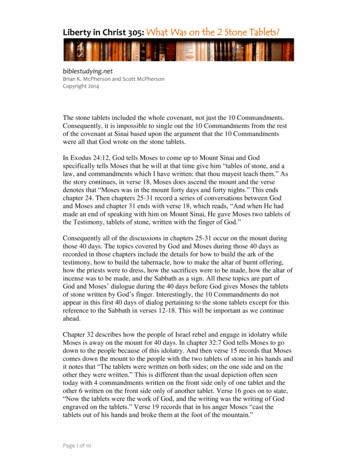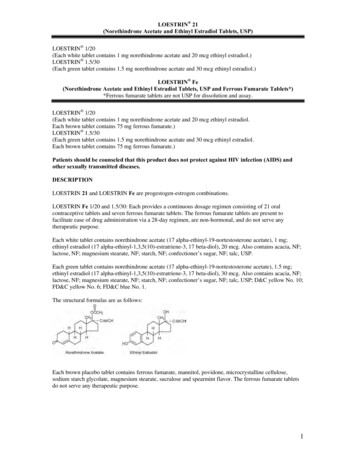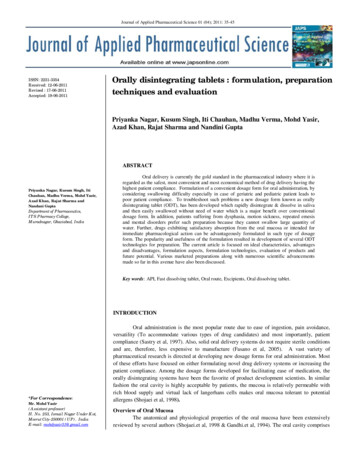
Transcription
HIGHLIGHTS OF PRESCRIBING INFORMATIONThese highlights do not include all the information needed to useTRULANCE safely and effectively. See full prescribinginformation for TRULANCE.TRULANCE (plecanatide) tablets, for oral useInitial U.S. Approval: 2017 DOSAGE FORMS AND STRENGTHS Tablets: 3 mg (3)WARNING: RISK OF SERIOUS DEHYDRATION INPEDIATRIC PATIENTSSee full prescribing information for complete boxed warning. CONTRAINDICATIONS Patients less than 6 years of age due to the risk of seriousdehydration. (4, 5.1, 8.4) Patients with known or suspected mechanical gastrointestinalobstruction. (4)TRULANCE is contraindicated in patients less than 6years of age; in young juvenile mice, plecanatide causeddeath due to dehydration. (4, 8.4)Avoid use of TRULANCE in patients 6 years to less than18 years of age. (5.1, 8.4)The safety and effectiveness of TRULANCE have notbeen established in patients less than 18 years of age.(8.4) WARNINGS AND PRECAUTIONS Diarrhea: Patients may experience severe diarrhea. If severediarrhea occurs, suspend dosing and rehydrate the patient. (5.2) ADVERSE REACTIONS Most common adverse reaction ( 2%) is diarrhea. (6.1) INDICATIONS AND USAGE TRULANCE is a guanylate cyclase-C agonist indicated in adults fortreatment of chronic idiopathic constipation (CIC). (1)To report SUSPECTED ADVERSE REACTIONS, contactSynergy Pharmaceuticals at 1-888-869-8869 or FDA at 1-800 FDA-1088 or www.fda.gov/medwatch. DOSAGE AND ADMINISTRATION The recommended adult dosage of TRULANCE is 3 mg taken orallyonce daily. (2.1)See 17 for PATIENT COUNSELING INFORMATION andMedication Guide.Administration Instructions (2.2): Take with or without food.Revised: 01/2017FULL PRESCRIBING INFORMATION: CONTENTS*WARNING: RISK OF SERIOUS DEHYDRATION INPEDIATRIC PATIENTS1234568Swallow tablets whole.For patients who have difficulty swallowing tablets whole orthose with a nasogastric or gastric feeding tube, see fullprescribing information with instructions for crushing thetablet and administering with applesauce or water.1112INDICATIONS AND USAGEDOSAGE AND ADMINISTRATION2.1 Recommended Dosage2.2 Preparation and Administration InstructionsDOSAGE FORMS AND STRENGTHSCONTRAINDICATIONSWARNINGS AND PRECAUTIONS5.1 Risk of Serious Dehydration in Pediatric Patients5.2 DiarrheaADVERSE REACTIONS6.1 Clinical Trials ExperienceUSE IN SPECIFIC POPULATIONS131416178.1 Pregnancy8.2 Lactation8.4 Pediatric Use8.5 Geriatric UseDESCRIPTIONCLINICAL PHARMACOLOGY12.1 Mechanism of Action12.2 Pharmacodynamics12.3 PharmacokineticsNONCLINICAL TOXICOLOGY13.1 Carcinogenesis, Mutagenesis, Impairment ofFertilityCLINICAL STUDIESHOW SUPPLIED/STORAGE AND HANDLINGPATIENT COUNSELING INFORMATION*Sections or subsections omitted from the full prescribinginformation are not listed.Reference ID: 40442521
FULL PRESCRIBING INFORMATIONWARNING: RISK OF SERIOUS DEHYDRATION IN PEDIATRIC PATIENTS 1TRULANCE is contraindicated in patients less than 6 years of age; in nonclinical studies in youngjuvenile mice administration of a single oral dose of plecanatide caused deaths due to dehydration[see Contraindications (4), Use in Specific Populations (8.4)].Avoid use of TRULANCE in patients 6 years to less than 18 years of age [see Warnings andPrecautions (5.1), Use in Specific Populations (8.4)].The safety and effectiveness of TRULANCE have not been established in patients less than 18years of age [see Use in Specific Populations (8.4)].INDICATIONS AND USAGETRULANCE is indicated in adults for the treatment of chronic idiopathic constipation (CIC).2DOSAGE AND ADMINISTRATION2.1 Recommended DosageThe recommended dosage of TRULANCE is 3 mg taken orally once daily.2.2 Preparation and Administration Instructions Take TRULANCE with or without food [see Clinical Pharmacology (12.3)].If a dose is missed, skip the missed dose and take the next dose at the regular time. Do not take twodoses at the same time.Swallow a tablet whole for each dose.For adult patients with swallowing difficulties, TRULANCE tablets can be crushed and administeredorally either in applesauce or with water or administered with water via a nasogastric or gastricfeeding tube. Mixing TRULANCE crushed tablets in other soft foods or in other liquids has notbeen tested.Oral Administration in Applesauce:1. In a clean container, crush the TRULANCE tablet to a powder and mix with 1 teaspoonful of roomtemperature applesauce.2. Consume the entire tablet-applesauce mixture immediately. Do not store the mixture for later use.Oral Administration in Water:1. Place the TRULANCE tablet in a clean cup.2. Pour approximately 30 mL of room temperature water into the cup.3. Mix by gently swirling the tablet and water mixture for at least 10 seconds. The TRULANCE tabletwill fall apart in the water.4. Swallow the entire contents of the tablet water mixture immediately.5. If any portion of the tablet is left in the cup, add another 30 mL of water to the cup, swirl for at least10 seconds, and swallow immediately.6. Do not store the tablet-water mixture for later use.Administration with Water via a Nasogastric or Gastric Feeding Tube:1. Place the TRULANCE tablet in a clean cup with 30 mL of room temperature water.2. Mix by gently swirling the tablet and water mixture for at least 15 seconds. The TRULANCE tabletwill fall apart in the water.3. Flush the nasogastric or gastric feeding tube with 30 mL of water using an appropriate syringe.2Reference ID: 4044252
4. Draw up the mixture using the syringe and immediately administer via the nasogastric or gastricfeeding tube. Do not reserve for future use.5. If any portion of the tablet is left in the cup, add another 30 mL of water to the cup, swirl for at least15 seconds, and using the same syringe, administer via the nasogastric or gastric feeding tube.6. Using the same or a fresh syringe, flush the nasogastric or gastric feeding tube with at least 10 mL ofwater.3DOSAGE FORMS AND STRENGTHSTRULANCE Tablets:3 mg: white to off-white, plain, round tablet debossed with “SP” on one side and “3” for 3 mg on the other side.4CONTRAINDICATIONSTRULANCE is contraindicated in: 5Patients less than 6 years of age due to the risk of serious dehydration [see Warnings and Precautions(5.1), Use in Specific Populations (8.4)].Patients with known or suspected mechanical gastrointestinal obstruction.WARNINGS AND PRECAUTIONS5.1 Risk of Serious Dehydration in Pediatric PatientsTRULANCE is contraindicated in patients less than 6 years of age. The safety and effectiveness ofTRULANCE in patients less than 18 years of age have not been established. In young juvenile mice (humanage equivalent of approximately 1 month to less than 2 years), plecanatide increased fluid-secretion into theintestines as a consequence of stimulation of guanylate cyclase-C (GC-C), resulting in mortality in some micewithin the first 24 hours, apparently due to dehydration. Due to increased intestinal expression of GC-C,patients less than 6 years of age may be more likely than patients 6 years of age and older to develop severediarrhea and its potentially serious consequences.Avoid the use of TRULANCE in patients 6 years to less than 18 years of age. Although there were no deaths inolder juvenile mice, given the deaths in younger mice and the lack of clinical safety and efficacy data inpediatric patients, avoid the use of TRULANCE in patients 6 years to less than 18 years of age [seeContraindications (4), Warnings and Precautions (5.2), Use in Specific Populations (8.4)].5.2 DiarrheaDiarrhea was the most common adverse reaction in the two placebo-controlled clinical trials. Severe diarrheawas reported in 0.6% of patients [see Adverse Reactions (6.1)]. If severe diarrhea occurs, suspend dosing andrehydrate the patient.6ADVERSE REACTIONS6.1 Clinical Trials ExperienceBecause clinical studies are conducted under widely varying conditions, adverse reaction rates observed in theclinical trials of a drug cannot be directly compared with rates in the clinical trials of another drug and may notreflect the rates observed in practice.The safety data described below reflect data from 1733 adult patients with CIC randomized in two double-blind,placebo-controlled clinical trials (Study 1 and Study 2) to receive placebo or 3 mg of TRULANCE once dailyfor 12 weeks. Demographic characteristics were comparable between the TRULANCE and placebo groups[see Clinical Studies (14)].3Reference ID: 4044252
Most Common Adverse ReactionsTable 1 provides the incidence of adverse reactions reported in at least 2% of CIC patients in theTRULANCE-treated group and at an incidence that was greater than in the placebo group.Table 1: Most Common Adverse Reactions* in Two Placebo-Controlled Trials of TRULANCE[Study 1 and Study 2] in Patients with CICAdverse ReactionDiarrhea*TRULANCE, 3 mg(N 863)%5Placebo(N 870)%1reported in at least 2% of TRULANCE-treated patients and at an incidence greater than placeboDiarrheaThe majority of reported cases of diarrhea occurred within 4 weeks of treatment initiation. Severe diarrhea wasreported in 0.6% of TRULANCE-treated patients compared to 0.3% of placebo-treated patients. Severediarrhea was reported to occur within the first 3 days of treatment [see Warnings and Precautions (5.2)].Adverse Reactions Leading to DiscontinuationDiscontinuations due to adverse reactions occurred in 4% of TRULANCE-treated patients and 2% ofplacebo-treated patients. The most common adverse reaction leading to discontinuation was diarrhea: 2% ofTRULANCE-treated patients and 0.5% of placebo-treated patients withdrew due to diarrhea.Less Common Adverse ReactionsAdverse reactions reported in less than 2% of TRULANCE-treated patients and at an incidence greater thanplacebo were: sinusitis, upper respiratory tract infection, abdominal distension, flatulence, abdominaltenderness, and increased liver biochemical tests (2 patients with alanine aminotransferase (ALT) greater than 5to 15 times the upper limit of normal and 3 patients with aspartate aminotransferase (AST) greater than 5 timesthe upper limit of normal).8USE IN SPECIFIC POPULATIONS8.1 PregnancyRisk SummaryPlecanatide and its active metabolite are negligibly absorbed systemically following oral administration [seeClinical Pharmacology (12.3)] and maternal use is not expected to result in fetal exposure to the drug. Theavailable data on TRULANCE use in pregnant women are not sufficient to inform any drug-associated risks formajor birth defects and miscarriage. In animal developmental studies, no effects on embryo-fetal developmentwere observed with oral administration of plecanatide in mice and rabbits during organogenesis at doses muchhigher than the recommended human dosage.The estimated background risk of major birth defects and miscarriage for the indicated population is unknown.All pregnancies have a background risk of birth defect, loss, or other adverse outcomes. In the United Statesgeneral population, the estimated background risk of major birth defects and miscarriage in clinicallyrecognized pregnancies is 2% to 4% and 15% to 20%, respectively.DataAnimal DataPregnant mice and rabbits were administered plecanatide during the period of organogenesis. There was noevidence of harm to embryo-fetal development at oral doses up to 800 mg/kg/day in mice and 250 mg/kg/day in4Reference ID: 4044252
rabbits. Oral administration of up to 600 mg/kg/day in mice during organogenesis through lactation producedno developmental abnormalities or effects on growth, learning and memory, or fertility in the offspring throughmaturation.The maximum recommended human dose is approximately 0.05 mg/kg/day, based on a 60-kg body weight.Limited systemic exposure to plecanatide was achieved in animals during organogenesis (area under the plasmaconcentration-time curve [AUCt] 449 ng h/mL in rabbits given 250 mg/kg/day). Plecanatide and its activemetabolite are not measurable in human plasma following administration of the recommended clinical dosage.Therefore, animal and human doses should not be compared directly for evaluating relative exposure.8.2 LactationRisk SummaryThere is no information regarding the presence of plecanatide in human milk, or its effects on milk productionor the breastfed infant. No lactation studies in animals have been conducted. Plecanatide and its activemetabolite are negligibly absorbed systemically following oral administration [see Clinical Pharmacology(12.3)].It is unknown whether the negligible systemic absorption of plecanatide by adults will result in a clinicallyrelevant exposure to breastfed infants. Exposure to plecanatide in breastfed infants has the potential for seriousadverse effects [see Use in Special Populations (8.4)]. The developmental and health benefits of breastfeedingshould be considered along with the mother’s clinical need for TRULANCE and any potential adverse effectson the breastfed infant from TRULANCE or from the underlying maternal condition.8.4 Pediatric UseTRULANCE is contraindicated in pediatric patients less than 6 years of age. Avoid use of TRULANCE inpatients 6 years to less than 18 years of age [see Contraindications (4), Warnings and Precautions (5.1)]. Thesafety and effectiveness of TRULANCE in patients less than 18 years of age have not been established.In nonclinical studies, deaths occurred within 24 hours in young juvenile mice (human age equivalent ofapproximately 1 month to less than 2 years) following oral administration of plecanatide, as described below inJuvenile Animal Toxicity Data. Because of increased intestinal expression of GC-C, patients less than 6 yearsof age may be more likely than patients 6 years of age and older to develop diarrhea and its potentially seriousconsequences. TRULANCE is contraindicated in patients less than 6 years of age. Given the deaths in youngjuvenile mice and the lack of clinical safety and efficacy data in pediatric patients, avoid the use ofTRULANCE in patients 6 years to less than 18 years of age.Juvenile Animal Toxicity DataSingle oral doses of plecanatide at 0.5 mg/kg and 10 mg/kg caused mortality in young juvenile mice onpostnatal days 7 and 14, respectively (human age equivalent of approximately 1 month to less than 2 years).Treatment-related increases in the weight of intestinal contents were observed in juvenile mice following singledoses of plecanatide on postnatal day 14 (human age equivalent of approximately less than 2 years), consistentwith increased fluid in the intestinal lumen. Although the recommended human dose is approximately 0.05mg/kg/day, based on a 60-kg body weight, plecanatide and its active metabolite are not measurable in adulthuman plasma, whereas systemic absorption was demonstrated in the juvenile animal toxicity studies. Animaland human doses should not be compared directly for evaluating relative exposure.8.5 Geriatric UseClinical studies of TRULANCE did not include sufficient numbers of patients aged 65 and over to determinewhether they respond differently from patients 18 years to less than 65 years of age. Of 2601 subjects inclinical trials of TRULANCE, 273 (10%) were 65 years of age and over, and 47 (2%) were 75 years and over.5Reference ID: 4044252
In general, dose selection for an elderly patient should be cautious, reflecting the greater frequency of decreasedhepatic, renal, or cardiac function, and of concomitant disease or other drug therapy.11 DESCRIPTIONTRULANCE (plecanatide) is a guanylate cyclase-C (GC-C) agonist. Plecanatide is a 16 amino acid peptidewith the following chemical name: L-Leucine, nyl-L-α l-L-valyl-L-alanyl-L-cysteinyl-L-threonylglycyl-L cysteinyl-, cyclic (4 12),(7 15)-bis(disulfide).The molecular formula of plecanatide is C65H104N18O26S4 and the molecular weight is 1682 Daltons. The aminoacid sequence for plecanatide is shown below:S l10-Ala11-Cys12-Thr13-Gly14-Cys15-Leu16-OHS SThe solid lines linking cysteines illustrate disulfide bridges.Plecanatide is an amorphous, white to off-white powder. It is soluble in water. TRULANCE tablets aresupplied as a 3 mg tablet for oral administration. The inactive ingredients are magnesium stearate andmicrocrystalline cellulose.12 CLINICAL PHARMACOLOGY12.1 Mechanism of ActionPlecanatide is structurally related to human uroguanylin, and similar to uroguanylin, plecanatide functions as aguanylate cyclase-C (GC-C) agonist. Both plecanatide and its active metabolite bind to GC-C and act locallyon the luminal surface of the intestinal epithelium. Activation of GC-C results in an increase in bothintracellular and extracellular concentrations of cyclic guanosine monophosphate (cGMP). Elevation ofintracellular cGMP stimulates secretion of chloride and bicarbonate into the intestinal lumen, mainly throughactivation of the cystic fibrosis transmembrane conductance regulator (CFTR) ion channel, resulting inincreased intestinal fluid and accelerated transit. In animal models, plecanatide has been shown to increasefluid secretion into the gastrointestinal (GI) tract, accelerate intestinal transit, and cause changes in stoolconsistency.In an animal model of visceral pain, plecanatide reduced abdominal muscle contractions, a measure of intestinalpain. The mechanism has not been studied.12.2 PharmacodynamicsFood EffectSubjects who received either a low-fat, low calorie (LF-LC) meal or a high fat, high calorie (HF-HC) mealreported looser stools than fasted subjects up to 24 hours after a single dose of TRULANCE 9 mg (3 times therecommended dose). In clinical studies, TRULANCE was administered with or without food [see Dosage andAdministration (2.2)].6Reference ID: 4044252
12.3 PharmacokineticsAbsorptionPlecanatide is minimally absorbed with negligible systemic availability following oral administration.Concentrations of plecanatide and its active metabolite in plasma are below the limit of quantitation after anoral TRULANCE dose of 3 mg. Therefore, standard pharmacokinetic parameters such as AUC, maximumconcentration (Cmax), and half-life (t½) cannot be calculated.Food EffectIn a crossover study, 24 healthy subjects were given a single dose of TRULANCE 9 mg (3 times therecommended dose) in 3 different states: fasted; following a low-fat, low-calorie meal (LF-LC; approximately350 calories: 17% from fat, 66% from carbohydrate, and 17% from protein); and following a high-fat,high-calorie meal (HF-HC; approximately 1000 calories: 60% from fat, 25% from carbohydrate, and 15% fromprotein). Plecanatide was detected in 1 subject (fasted state) at 0.5 and 1 hour post dose. Plecanatideconcentrations were below the limit of quantitation for all other time points and for all other subjects. Theactive metabolite was not detected in any subject.DistributionGiven that plecanatide concentrations following clinically relevant oral doses are not measurable, plecanatide isexpected to be minimally distributed in tissues. Oral plecanatide is localized to the GI tract where it exerts itseffects as a GC-C agonist with negligible systemic exposure. Plecanatide exhibits little to no binding to humanserum albumin or human α-1-acid glycoprotein.EliminationMetabolismPlecanatide is metabolized in the GI tract to an active metabolite by loss of the terminal leucine moiety. Bothplecanatide and the metabolite are proteolytically degraded within the intestinal lumen to smaller peptides andnaturally occurring amino acids.ExcretionNo excretion studies have been conducted in humans. Plecanatide and its active metabolite are not measurablein plasma following administration of the recommended clinical doses.Drug Interaction StudiesNeither plecanatide nor its active metabolite inhibited the cytochrome P450 (CYP) enzymes 2C9 and 3A4, andthey did not induce CYP3A4 in vitro.Plecanatide and its active metabolite are neither substrates nor inhibitors of the transporters P-glycoprotein(P-gp) or breast cancer resistance protein (BCRP) in vitro.13 NONCLINICAL TOXICOLOGY13.1 Carcinogenesis, Mutagenesis, Impairment of FertilityCarcinogenesisThe carcinogenic potential of plecanatide was assessed in 2-year carcinogenicity studies in mice and rats.Plecanatide was not tumorigenic in mice at oral doses up to 90 mg/kg/day or in rats at oral doses up to100 mg/kg/day. Limited systemic exposure to plecanatide was achieved at the tested dose levels in animals,whereas no detectable exposure occurred in humans. Therefore, animal and human doses should not becompared directly for evaluating relative exposure.7Reference ID: 4044252
MutagenesisPlecanatide was not genotoxic in the in vitro bacterial reverse mutation (Ames) assay, in vitro mouse lymphomamutation assay, or the in vivo mouse bone marrow micronucleus assay.Impairment of FertilityPlecanatide had no effect on fertility or reproductive function in male or female mice at oral doses of up to600 mg/kg/day.14 CLINICAL STUDIESThe efficacy of TRULANCE for the management of symptoms of CIC was established in two 12-week,double-blind, placebo-controlled, randomized, multicenter clinical studies in adult patients (Study 1 andStudy 2). In the Intention-to-Treat (ITT) population, a total of 905 patients (Study 1) and 870 patients (Study 2)were randomized 1:1 to either placebo or TRULANCE 3 mg, once daily. In clinical studies, study medicationwas administered without respect to food intake. Demographics for these studies included an overall mean ageof 45 years (range 18 to 80 years), 80% female, 72% white, and 24% black.To be eligible for the studies, patients were required to meet modified Rome III criteria for at least 3 monthsprior to the screening visit, with symptom onset for at least 6 months prior to diagnosis. Rome III criteria weremodified to require that patients report less than 3 defecations per week, rarely have a loose stool without theuse of laxatives, not use manual maneuvers to facilitate defecations, and not meet criteria for IBS-C. Inaddition, patients were required to report at least two of the following symptoms: Straining during at least 25% of defecationsLumpy or hard stool in at least 25% of defecationsSensation of incomplete evacuations for at least 25% of defecationsSensation of anorectal obstruction/blockage for at least 25% of defecationsPatients who met these criteria were also required to demonstrate the following during the last 2 weeks of thescreening period: Less than 3 complete spontaneous bowel movements (CSBMs) (a CSBM is an SBM that is associatedwith a sense of complete evacuation) in each of the two weeksBristol Stool Form Scale (BSFS) of 6 or 7 in less than 25% of spontaneous bowel movements (SBMs)(an SBM is a bowel movement occurring in the absence of laxative use)One out of the following three:o BSFS of 1 or 2 in at least 25% of defecationso A straining value recorded on at least 25% of days when a BM was reportedo At least 25% of BMs result in a sense of incomplete evacuationThe efficacy of TRULANCE was assessed using a responder analysis and change-from-baseline in CSBM andSBM endpoints. Efficacy was assessed using information provided by patients on a daily basis in an electronicdiary.A responder was defined as a patient who had a least 3 CSBMs in a given week and an increase of at least 1CSBM from baseline in the same week for at least 9 weeks out of the 12 week treatment period and at least 3 ofthe last 4 weeks of the study. The responder rates are shown in Table 2.8Reference ID: 4044252
Table 2: Efficacy Responder Rates in the Two Placebo Controlled Studies of CIC: at least 9 of 12 weeksand at least 3 of the last 4 weeks (ITT Population)Study 1Responder TRULANCE 3 mgN 453PlaceboN 45221%10%TreatmentDifference#[95% CI*]11%[6.1%, 15.4%]Study 2Responder TRULANCE 3 mgN 430PlaceboN 44021%13%TreatmentDifference#[95% CI*]8%[2.6%, 12.4%]*CI confidence intervalprimary endpoint defined as a patient who had a least 3 CSBMs in a given week and an increase of at least 1 CSBM from baseline inthe same week for at least 9 weeks out of the 12 week treatment period and at least 3 of the last 4 weeks of the study#p-value 0.005 In both studies, improvements in the frequency of CSBMs/week were seen as early as week 1 withimprovement maintained through week 12. The difference between the TRULANCE group and the placebogroup in the mean change of CSBMs/week frequency from baseline to week 12 was approximately1.1 CSBMs/week.Over the 12 week treatment period, improvements were observed in stool frequency (number of CSBMs/weekand SBMs/week) and/or stool consistency (as measured by the BSFS), and/or in the amount of straining withbowel movements (amount of time pushing or physical effort to pass stool) in the TRULANCE group ascompared to placebo.Following completion of the study drug treatment period, patients continued to record data in the daily diary fora 2 week Post-Treatment Period. During this time, TRULANCE-treated patients generally returned to baselinefor these study endpoints.In Studies 1 and 2, a third randomized treatment arm of TRULANCE 6 mg once daily did not demonstrateadditional treatment benefit and had a greater incidence of adverse reactions than TRULANCE 3 mg once daily.Therefore, TRULANCE 6 mg once daily is not recommended [see Dosage and Administration (2.1)].16 HOW SUPPLIED/STORAGE AND HANDLINGTRULANCE tablets are packaged in an aluminum foil unit dose blister pack of 30 in a child-resistant pack or ina white, opaque, high-density polyethylene round bottle with a screw-top polypropylene child-resistant cap andheat-activated induction seal. Each bottle container-closure system also contains a desiccant and a polyestercoil.TRULANCE 3 mg tablets are white to off-white, plain and round, debossed with “SP” on one side and “3” for3 mg on the other side and supplied as:NDC NumberSize70194-203-30Bottle of 3070194-003-30Aluminum foil unit dose blister pack of 30 in a child-resistant pack9Reference ID: 4044252
Store at room temperature, 20 to 25 C (68 to 77 F); excursions permitted to 15 to 30 C (59 to 86 F) [see USPControlled Room Temperature].Keep TRULANCE in a dry place. Protect from moisture. For bottles, keep TRULANCE in the original bottle.Do not remove desiccant from the bottle. Do not subdivide or repackage.17 PATIENT COUNSELING INFORMATIONAdvise the patient to read the FDA-approved patient labeling (Medication Guide).Advise Patients:DiarrheaTo stop TRULANCE and contact their healthcare provider if they experience severe diarrhea [see Warningsand Precautions (5.2)].Accidental IngestionAccidental ingestion of TRULANCE in children, especially in children less than 6 years of age, may result insevere diarrhea and dehydration. Instruct patients to take steps to store TRULANCE securely and out of reachof children and to dispose of unused TRULANCE [see Contraindications (4), Warnings and Precautions (5.2)].Administration and Handling Instructions To take TRULANCE once daily with or without food [see Dosage and Administration (2.2)].If a dose is missed, skip the missed dose and take the next dose at the regular time. Do not take two doses atthe same time.To swallow TRULANCE tablets whole.If adult patients have swallowing difficulties, TRULANCE tablets can be crushed and administered orally ineither applesauce or with water, or administered with water via a nasogastric or gastric feeding tube, asdescribed in the Medication Guide.To keep TRULANCE in a dry place. Protect from moisture. For bottles, keep TRULANCE in the originalbottle. Do not remove desiccant from the bottle. Do not subdivide or repackage. Remove and discardpolyester coil after opening. Keep bottles closed tightly [see How Supplied/Storage and Handling (16)].TRULANCE is a trademark of Synergy Pharmaceuticals Inc.Manufactured for:Synergy Pharmaceuticals Inc.420 Lexington Avenue, Suite 2012New York, New York 1017010Reference ID: 4044252
Medication GuideTRULANCE (troo’ lans)(plecanatide) tabletsWhat is the most important information I should know about TRULANCE? Do not give TRULANCE to children who are less than 6 years of age. It may harm them. You should not give TRULANCE to children 6 years to less than 18 years of age. It may harmthem.See “What are the possible side effects of TRULANCE?” for more information about side effects.What is TRULANCE?TRULANCE is a prescription medicine used in adults to treat a type of constipation called chronicidiopathic constipation (CIC). Idiopathic means the cause of the constipation is unknown.It is not known if TRULANCE is safe and effective in children less than 18 years of age.Who should not take TRULANCE? Do not give TRULANCE to children who are less than 6 years of age. Do not take TRULANCE if a doctor has told you that you have a bowel blockage (intestinal obstruction).Before taking TRULANCE, tell your doctor about all of your medical conditions, including if you: are pregnant or plan to become pregnant. It is not known if TRULANCE will harm your unborn baby. are breastfeeding or plan to breastfeed. It is not known if TRULANCE passes into your breast milk.Talk with your doctor about the best way to feed your baby if you take TRULANCE.Tell your doctor about all the medicines you take, including prescription and over-the-countermedicines, vitamins, and herbal supplements.How should I take TRULANCE? Take TRULANCE exactly as your doctor tells you to take it. Take TRULANCE by mouth, 1 time each day with or without food. If you miss a dose, skip the missed dose. Take the next dose at your regular time. Do not take 2doses at the same time. TRULANCE tablets should be swallowed whole.o Adults who cannot swallow TRULANCE tablets whole may crush the TRULANCE tablet and mix withapplesauce or dissolve TRULANCE in water before swallowing. TRULANCE tablets may also betaken with water by adults through a nasogastric or gastric feeding tube.It is not known if TRULANCE is safe
Less Common Adverse Reactions Adverse reactions reported in less than 2% of TRULANCE-treated patients and at an incidence greater than placebo were: sinusitis, upper respiratory tract infection, abdominal distension, flatulence, abdominal










